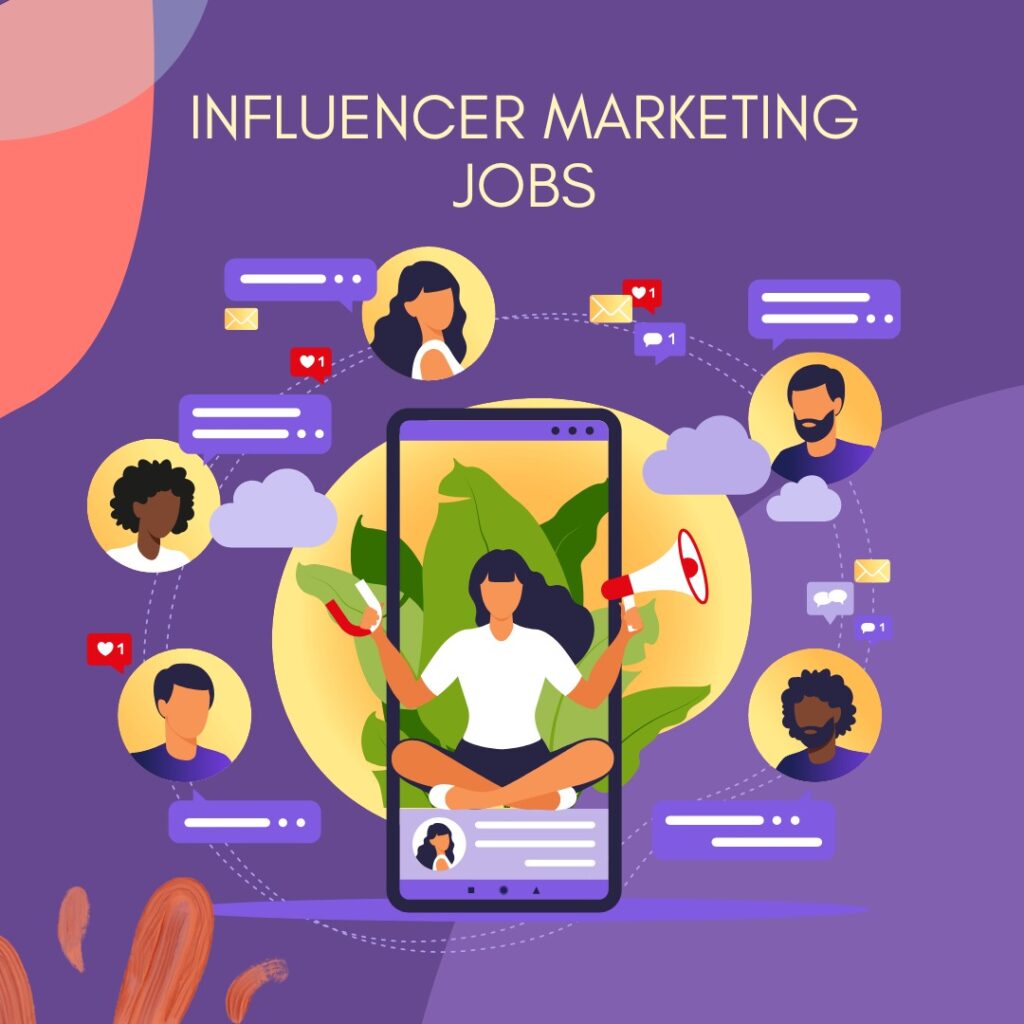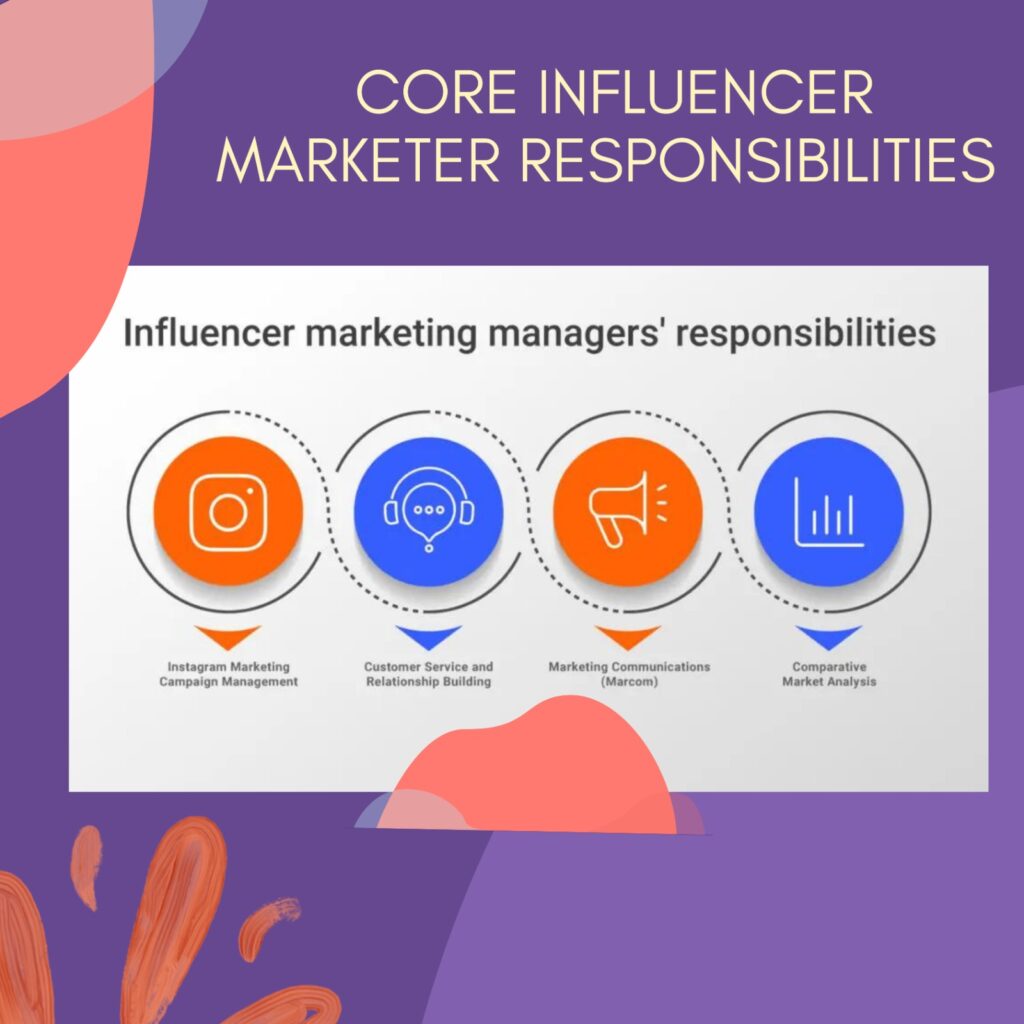Influencer marketing jobs typically involve working with social media influencers to promote a brand or product.

Job roles in this field can include:
- Influencer Marketing Manager: responsible for developing and executing influencer marketing campaigns.
- Social Media Manager manages the brand’s social media presence and collaborates with influencers to promote the brand.
- Brand Ambassador: serves as the face of the brand and works with influencers to promote products.
- Marketing Coordinator: supports the marketing team in executing influencer campaigns and tracking their success.
Core Influencer Marketer Responsibilities
The core responsibilities of an influencer marketer may include the following:

- Identifying potential influencer partners and evaluating their fit with the brand.
- Negotiating influencer partnerships and contracts.
- Developing and executing influencer marketing campaigns.
- Collaborating with influencers to create content that aligns with the brand’s messaging and aesthetic.
- Managing and tracking the performance of influencer campaigns.
- Analyzing and reporting on the success of influencer marketing efforts.
- Staying up-to-date with industry trends and new platform features to continually improve influencer marketing strategies.
- Building and maintaining relationships with influencer partners.
- Ensuring that influencer campaigns comply with legal and ethical guidelines.
- Developing and managing budgets for influencer marketing activities.
Strategic Mastermind
A strategic mastermind is a group of individuals who share ideas, knowledge, and resources to achieve a common goal. In business and marketing, a strategic mastermind can refer to a group of individuals who collaborate to develop and execute strategic plans for a company or brand.

The purpose of a strategic mastermind is to bring together experts from different fields and perspectives to create innovative and effective strategies. Members of a strategic mastermind may be business owners, executives, marketers, consultants, or other experts who can contribute their unique skills and experiences to the group.
A strategic mastermind may meet regularly to discuss and review progress, provide support, and hold each other accountable for achieving their goals.
Project Manager
A project manager is responsible for overseeing and coordinating the successful completion of a specific, short-term project.

- Defining project scope and objectives.
- Developing a project plan, including tasks, timeline, budget, and resources needed.
- Managing project risks and adapting the plan as necessary.
- Communicating with stakeholders, including the project team, clients, and senior management.
- Tracking and reporting on project progress, including regular status updates and presentations.
- Facilitating meetings and decision-making processes to keep the project moving forward.
- Managing relationships with project stakeholders and resolving any conflicts that arise.
- Closing the project and conducting a post-project review to identify areas for improvement.
Relationship Builder
A relationship builder is a person who specializes in creating and maintaining strong, positive relationships with others. This can be in a professional or personal context, and the role can be found in many different industries and organizations.

- Networking: meeting and connecting with new people to build a large network of contacts.
- Building rapport: using active listening, empathy, and communication skills to establish trust and understanding with others.
- Maintaining relationships: regularly communicating and spending time with existing contacts to deepen relationships.
- Collaborating: working with others to achieve common goals and build mutually beneficial relationships.
- Resolving conflicts: addressing and resolving any misunderstandings or disputes that arise in relationships.
- Representing the organization: acting as an ambassador and promoting its values and goals in relationships.
- Identifying opportunities: recognizing opportunities for new relationships and partnerships that can benefit the organization.
Data Scientist
A data scientist must have a strong background in mathematics, statistics, and computer science and experience with programming languages such as Python and R.
The role typically involves:
- Collecting, cleaning, and organizing large datasets.
- Analyzing data using statistical techniques and algorithms to identify patterns and trends.
- Building predictive models to forecast future outcomes based on past data.
- Communicating insights and recommendations to stakeholders through data visualizations and presentations.
- Developing and implementing data-driven solutions to business problems.
- Staying up-to-date with the latest technologies and tools in data science.
Social Trend Spotter
A social trend spotter is a person who closely monitors social media and popular culture to identify emerging trends and patterns. This role is often found in the marketing, advertising, or media industries, where the ability to stay ahead of the curve can provide a significant advantage.
The responsibilities of a social trendspotter may include the following:
- Analyzing data to identify patterns and themes in social media activity.
- Staying up-to-date with the latest cultural and social trends, including music, fashion, technology, and politics.
- Reporting on and communicating trends to stakeholders, including senior management, marketing teams, and clients.
- Identifying potential implications of emerging trends for the organization or brand.
- Collaborating with other departments to develop strategies incorporating emerging trends into their work.
- Participating in brainstorming sessions to generate creative and innovative ideas.
How to Create an Influencer Marketing Strategy
An influencer marketing strategy is a plan for using influencer marketing to achieve specific business goals.
- Define your target audience: Identify your ideal customer’s demographic, interests, and behaviours.
- Set your goals: Determine what you want to achieve with your influencer marketing campaigns, such as increased brand awareness, sales, or engagement.
- Determine the right content: Decide what content will best engage your target audience and align with your business goals. This may include product reviews, tutorials, or brand-sponsored content.
- Create a budget: Determine the amount of money you will invest in your influencer marketing campaign, considering the costs of working with influencers and any additional resources needed to execute the campaign.
- Develop your campaign: Create a detailed plan for executing your influencer marketing campaign, including timelines, deliverables, and responsibilities for each team member.
1. Determine your goals
The first step in creating an influencer marketing strategy is determining your goals. This involves considering what you hope to achieve with your influencer marketing campaign and setting specific, measurable targets.
- Boosting sales: Influencer marketing can help drive sales by promoting your products or services to a large and engaged audience.
- Improving engagement: By partnering with popular influencers with your target audience, you can improve engagement with your brand and increase your reach on social media.
- Building brand loyalty: Influencer marketing can help you build brand loyalty by creating positive associations with your brand and establishing a deeper connection with your target audience.
- Generating leads: You can use influencer marketing to direct followers to landing pages or sign-up forms where they can learn more about your products or services.
2. Know who you’re trying to influence
The second step in creating an influencer marketing strategy is to know who you’re trying to influence. This involves defining your target audience and understanding their needs, interests, and behaviours. To do this, you can conduct market research to gather information about your target audience, including:
- Demographics: Age, gender, income, education level, location, etc.
- Interests: Hobbies, leisure activities, favourite brands, etc.
- Behaviours: Purchasing habits, social media usage, etc.
- Pain points: The problems or challenges that your target audience is facing.
3. Understand the rules
The third step in creating an influencer marketing strategy is understanding the rules.
For example, in the United States, the Federal Trade Commission (FTC) requires influencers to use clear and conspicuous language, such as “sponsored” or “ad”,
It’s important to be aware of these rules and regulations and to ensure that your influencer marketing campaign complies with them.
4. Consider the three Rs of influence
The fourth step in creating an influencer marketing strategy is considering the three Rs of influence: reach, relevance, and resonance.
- Reach: An influencer’s reach refers to their audience size and potential to reach new people.
- Relevance: The relevance of an influencer refers to how well they align with your target audience and the topics they typically cover.
- Resonance: The resonance of an influencer refers to how well they connect with their audience and their impact on their followers. Consider choosing influencers with a strong personal brand and creating content that resonates with their audience.
5. Compile a short list of influencers
The fifth step in creating an influencer marketing strategy is to compile a shortlist of influencers. This involves researching and identifying potential influencers who align with your target audience and goals and have a large and engaged following.
There are several ways to identify potential influencers, including:
- Social media: Look for active influencers on platforms such as Instagram, YouTube, TikTok, and Twitter who have a large and engaged following in your target audience.
- Influencer marketing platforms: There are various influencer marketing platforms, such as AspireIQ, Klear, and Influencer.
- Competitor research: Look at the influencer marketing campaigns of your competitors to see who they are working with and what kind of results they are achieving.
6. Do your research
The sixth step in creating an influencer marketing strategy is researching. This involves thoroughly researching the influencers on your shortlist to ensure they fit your brand and goals well.
- Audience demographics: Look at the age, gender, location, and interests of the Influencer’s audience to ensure they align with your target audience.
- Engagement rate: Check the engagement rate of the Influencer’s posts to determine how well they connect with their audience and how likely they are to generate results for your brand.
- Quality of content: Evaluate the quality of the Influencer’s content to determine if it’s relevant and valuable to their audience and if it aligns with your brand’s values and goals.
- Brand alignment: Look at the Influencer’s past work and partnerships to determine if they align with your brand values and goals and if they have a history of promoting products and services relevant to your industry or niche.
8. Collaborate with your Influencer to develop effective content
To develop effective content with an influencer, it is important to communicate with them and understand their strengths, audience, and style.
Work with them to align your goals and ideas for the content and clearly understand the message you want to convey. Brainstorm and create a content plan that showcases your brand and appeals to the Influencer’s followers.
7. Reach out privately and personally
This means researching the Influencer to understand their interests and preferences and customizing your outreach message accordingly.
Avoid using generic templates; instead, craft a personalized message highlighting why you think they would be a good fit for your brand. Show genuine interest in their work and respect their time and boundaries. This approach can help establish a positive and authentic relationship with the Influencer and increase the likelihood of a successful collaboration.
9. Measure your results
Measuring the results of a collaboration with an influencer is crucial to assess its success and making data-driven decisions for future campaigns.
Some metrics to engagement rates on social media posts, website traffic and conversion rates, and brand awareness and recall.



Add a Comment